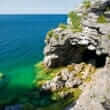Background
- Dolomite is a sedimentary carbonate rock or mineral composed of calcium magnesium carbonate crystals. Dolomite was first described in 1791 by the French naturalist and geologist Déodat Gratet de Dolomieu (1750-1801). He observed dolomite in a mountain group in northern Italy, now named the Dolomite Alps. Dolomite rock (or dolostone) is mainly composed of the mineral dolomite. Dolomitic limestone (or magnesian limestone) is limestone that is partially replaced by dolomite.
- Dolomite is commonly used for its potential ability to act as a calcium and magnesium supplement, although its safety and effectiveness as such has yet to be proven. Evidence supporting dolomite's use in any other human condition is lacking.
References
- Belcastro, P. A. Pedagogical patronizing of the pharmacodynamic promises of illicit drugs. J.Drug Educ. 1992;22(1):9-13.
View Abstract - Bourgoin, B. P., Evans, D. R., Cornett, J. R., et al. Lead content in 70 brands of dietary calcium supplements. Am.J.Public Health 1993;83(8):1155-1160.
View Abstract - Chen, G. C., He, Z. L., Stoffella, P. J., et al. Leaching potential of heavy metals (Cd, Ni, Pb, Cu and Zn) from acidic sandy soil amended with dolomite phosphate rock (DPR) fertilizers. J.Trace Elem.Med.Biol. 2006;20(2):127-133.
View Abstract - Fukaya, Y., Matsumoto, T., Gotoh, M., et al. [Lead exposure of workers in the ceramics industry and relevant factors]. Nippon Eiseigaku Zasshi 1993;48(5):980-991.
View Abstract - Gault, M. H., Chafe, L., Longerich, L., et al. Calcium and calcium magnesium carbonate specimens submitted as urinary tract stones. J.Urol. 1993;149(2):244-249.
View Abstract - Mattos, J. C., Hahn, M., Augusti, P. R., et al. Lead content of dietary calcium supplements available in Brazil. Food Addit.Contam 2006;23(2):133-139.
View Abstract - Mizoguchi, T., Nagasawa, S., Takahashi, N., et al. Dolomite supplementation improves bone metabolism through modulation of calcium-regulating hormone secretion in ovariectomized rats. J.Bone Miner.Metab 2005;23(2):140-146.
View Abstract - Quintaes, K. D., Amaya-Farfan, J., Morgano, M. A., et al. Soapstone (steatite) cookware as a source of minerals. Food Addit.Contam 2002;19(2):134-143.
View Abstract - Reid, J. D. and Andersen, M. E. Calcium oxalate in sarcoid granulomas. With particular reference to the small ovoid body and a note on the finding of dolomite. Am.J.Clin.Pathol. 1988;90(5):545-558.
View Abstract - Roberts, H. J. Potential toxicity due to dolomite and bonemeal. South.Med.J. 1983;76(5):556-559.
View Abstract - Roberts, R. J. Dolomite as a source of toxic metals. N.Engl.J.Med. 2-12-1981;304(7):423.
View Abstract - Scelfo, G. M. and Flegal, A. R. Lead in calcium supplements. Environ.Health Perspect. 2000;108(4):309-313.
View Abstract - Selden, A. I., Berg, N. P., Lundgren, E. A., et al. Exposure to tremolite asbestos and respiratory health in Swedish dolomite workers. Occup.Environ.Med. 2001;58(10):670-677.
View Abstract - Steenkamp, V., Stewart, M. J., Curowska, E., et al. A severe case of multiple metal poisoning in a child treated with a traditional medicine. Forensic Sci.Int. 8-28-2002;128(3):123-126.
View Abstract - Yamana, H., Ito, H., Ito, T., et al. Strong antiviral activity of heated and hydrated dolomite--preliminary investigation. J.Vet.Med.Sci. 2007;69(2):217-219.
View Abstract







